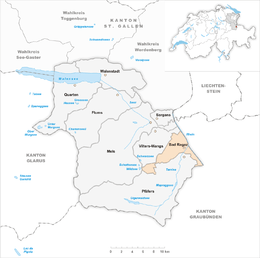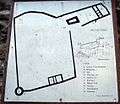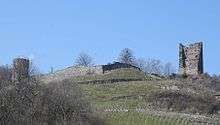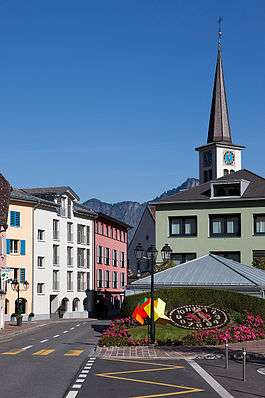Bad Ragaz
| Bad Ragaz | ||
|---|---|---|
|
Bad Ragaz - main square | ||
| ||
 Bad Ragaz | ||
|
Location of Bad Ragaz  | ||
| Coordinates: 47°00′N 9°30′E / 47.000°N 9.500°ECoordinates: 47°00′N 9°30′E / 47.000°N 9.500°E | ||
| Country | Switzerland | |
| Canton | St. Gallen | |
| District | Sarganserland | |
| Government | ||
| • Mayor | Guido Germann | |
| Area[1] | ||
| • Total | 25.4 km2 (9.8 sq mi) | |
| Elevation | 516 m (1,693 ft) | |
| Population (Dec 2015[2]) | ||
| • Total | 5,739 | |
| • Density | 230/km2 (590/sq mi) | |
| Postal code | 7310 | |
| SFOS number | 3291 | |
| Surrounded by | Fläsch (GR), Maienfeld (GR), Mastrils (GR), Mels, Pfäfers, Vilters-Wangs | |
| Website |
www SFSO statistics | |
Bad Ragaz is a municipality in the Wahlkreis (constituency) of Sarganserland in the canton of St. Gallen in Switzerland.
It is the home of a famous natural spring and is a popular spa and health resort destination. One of the largest spa hotels is the Grand Hotel Quellenhof.
History
Bad Ragaz is first mentioned about 843 as Ragaces.[3] Chlodwig, Prince of Hohenlohe-Schillingsfürst died here in 1901.
Geography
Bad Ragaz has an area, as of 2006, of 25.4 km2 (9.8 sq mi). Of this area, 45.4% is used for agricultural purposes, while 34.9% is forested. Of the rest of the land, 9.6% is settled (buildings or roads) and the remainder (10.1%) is non-productive (rivers or lakes).[4]
The municipality is in the Sarganserland WahlkreisBez. Sargans. The spa and recreation village is in the south-east of the canton at the end of the Tamina valley. It lies on the north-south and east-west routes over the Graubünden Alps. Until 1937 Bad Ragaz was known as Ragaz.[5]
Coat of arms
The blazon of the municipal coat of arms is Azure a Dove volant displayed Argent beaked and membered Or having a sprig Gules in the beak.[6]
Demographics
Bad Ragaz has a population (as of 31 December 2015) of 5,739.[7] As of 2007, about 25.1% of the population was made up of foreign nationals. Of the foreign population, (as of 2000), 122 are from Germany, 144 are from Italy, 508 are from ex-Yugoslavia, 59 are from Austria, 1 person is from Turkey, and 312 are from another country.[8] Over the last 10 years the population has grown at a rate of 8.3%. Most of the population (as of 2000) speaks German (84.9%), with Serbo-Croatian being second most common ( 4.3%) and Italian being third ( 2.9%).[4] Of the Swiss national languages (as of 2000), 4,184 speak German, 30 people speak French, 141 people speak Italian, and 45 people speak Romansh.[9]
The age distribution, as of 2000, in Bad Ragaz is; 503 children or 10.2% of the population are between 0 and 9 years old and 626 teenagers or 12.7% are between 10 and 19. Of the adult population, 591 people or 12.0% of the population are between 20 and 29 years old. 810 people or 16.4% are between 30 and 39, 756 people or 15.3% are between 40 and 49, and 640 people or 13.0% are between 50 and 59. The senior population distribution is 476 people or 9.7% of the population are between 60 and 69 years old, 318 people or 6.5% are between 70 and 79, there are 174 people or 3.5% who are between 80 and 89, and there are 35 people or 0.7% who are between 90 and 99.[9]
In 2000 there were 765 persons (or 15.5% of the population) who were living alone in a private dwelling. There were 1,181 (or 24.0%) persons who were part of a couple (married or otherwise committed) without children, and 2,390 (or 48.5%) who were part of a couple with children. There were 290 (or 5.9%) people who lived in single parent home, while there are 36 persons who were adult children living with one or both parents, 24 persons who lived in a household made up of relatives, 35 who lived household made up of unrelated persons, and 208 who are either institutionalized or live in another type of collective housing.[9]
In the 2007 federal election the most popular party was the SVP which received 40.3% of the vote. The next three most popular parties were the CVP (21.4%), the FDP (13.7%) and the SP (12.7%).[4]
The entire Swiss population is generally well educated. In Bad Ragaz about 68.9% of the population (between age 25-64) have completed either non-mandatory upper secondary education or additional higher education (either university or a Fachhochschule).[4] Out of the total population in Bad Ragaz, as of 2000, the highest education level completed by 1,070 people (21.7% of the population) was Primary, while 1,975 (40.1%) have completed Secondary, 558 (11.3%) have attended a Tertiary school, and 175 (3.6%) are not in school. The remainder did not answer this question.[9]
The historical population is given in the following table:[3]
| year | population |
|---|---|
| 1800 | 954 |
| 1850 | 1,366 |
| 1880 | 1,993 |
| 1900 | 1,866 |
| 1950 | 2,584 |
| 1970 | 3,713 |
| 1990 | 4,325 |
Heritage sites of national significance
The Village Baths (German: Dorfbad) with the water cure rooms (German: Trinkhalle) at Bartholoméplatz 1, the chapel of St. Leonhard and the ruins of Freudenberg Castle are listed as Swiss heritage sites of national significance.[10]
-

Floorplan of Castle Freudenberg
-

View of the castle site
-

Chapel of St. Leonhard
Economy
As of 2007, Bad Ragaz had an unemployment rate of 1.62%. As of 2005, there were 103 people employed in the primary economic sector and about 23 businesses involved in this sector. 687 people are employed in the secondary sector and there are 71 businesses in this sector. 1,911 people are employed in the tertiary sector, with 244 businesses in this sector.[4]
As of October 2009 the average unemployment rate was 3.0%.[11] There were 331 businesses in the municipality of which 64 were involved in the secondary sector of the economy while 248 were involved in the third.[12]
As of 2000 there were 1,510 residents who worked in the municipality, while 1,217 residents worked outside Bad Ragaz and 1,189 people commuted into the municipality for work.[13]
Religion
From the 2000 census, 2,862 or 58.1% are Roman Catholic, while 1,105 or 22.4% belonged to the Swiss Reformed Church. Of the rest of the population, there is 1 individual who belongs to the Christian Catholic faith, there are 249 individuals (or about 5.05% of the population) who belong to the Orthodox Church, and there are 64 individuals (or about 1.30% of the population) who belong to another Christian church. There are 2 individuals (or about 0.04% of the population) who are Jewish, and 166 (or about 3.37% of the population) who are Islamic. There are 42 individuals (or about 0.85% of the population) who belong to another church (not listed on the census), 277 (or about 5.62% of the population) belong to no church, are agnostic or atheist, and 161 individuals (or about 3.27% of the population) did not answer the question.[9]
Climate
Between 1961 and 1990 Bad Ragaz had an average of 120.5 days of rain or snow per year and on average received 830 mm (33 in) of precipitation. The wettest month was August during which time Bad Ragaz receives an average of 109 mm (4.3 in) of rain or snow. During this month there was precipitation for an average of 12.7 days. The driest month of the year was October with an average of 49 mm (1.9 in) of precipitation over 12.7 days.[14]
| Climate data for Bad Ragaz (1981-2010) | |||||||||||||
|---|---|---|---|---|---|---|---|---|---|---|---|---|---|
| Month | Jan | Feb | Mar | Apr | May | Jun | Jul | Aug | Sep | Oct | Nov | Dec | Year |
| Average high °C (°F) | 3.9 (39) |
5.4 (41.7) |
10.5 (50.9) |
14.9 (58.8) |
19.8 (67.6) |
22.3 (72.1) |
24.5 (76.1) |
23.8 (74.8) |
20.0 (68) |
15.9 (60.6) |
8.9 (48) |
4.8 (40.6) |
14.6 (58.3) |
| Daily mean °C (°F) | 0.5 (32.9) |
1.6 (34.9) |
6.0 (42.8) |
9.8 (49.6) |
14.4 (57.9) |
17.1 (62.8) |
19.2 (66.6) |
18.7 (65.7) |
15.1 (59.2) |
11.2 (52.2) |
5.3 (41.5) |
1.7 (35.1) |
10.1 (50.2) |
| Average low °C (°F) | −2.5 (27.5) |
−1.7 (28.9) |
2.1 (35.8) |
5.3 (41.5) |
9.7 (49.5) |
12.6 (54.7) |
14.7 (58.5) |
14.5 (58.1) |
11.2 (52.2) |
7.3 (45.1) |
2.2 (36) |
−1.2 (29.8) |
6.2 (43.2) |
| Average precipitation mm (inches) | 52 (2.05) |
52 (2.05) |
63 (2.48) |
55 (2.17) |
70 (2.76) |
92 (3.62) |
102 (4.02) |
111 (4.37) |
79 (3.11) |
54 (2.13) |
63 (2.48) |
58 (2.28) |
850 (33.46) |
| Average snowfall cm (inches) | 33.2 (13.07) |
32.9 (12.95) |
18.5 (7.28) |
1.8 (0.71) |
0.7 (0.28) |
0 (0) |
0 (0) |
0 (0) |
0 (0) |
0.1 (0.04) |
12 (4.7) |
24.6 (9.69) |
123.8 (48.74) |
| Average precipitation days (≥ 1.0 mm) | 8.7 | 7.6 | 10.1 | 9.4 | 11.2 | 12.3 | 12.2 | 13.0 | 9.1 | 7.9 | 9.5 | 9.3 | 120.3 |
| Average snowy days (≥ 1.0 cm) | 4.9 | 4.7 | 3.5 | 0.6 | 0.1 | 0 | 0 | 0 | 0 | 0 | 2.2 | 4.2 | 20.2 |
| Average relative humidity (%) | 80.7 | 78.1 | 73.3 | 70.9 | 70.6 | 71.9 | 73.1 | 74.8 | 75.9 | 77.9 | 79.8 | 82.3 | 75.8 |
| Source: MeteoSwiss [15] | |||||||||||||
Personality

- Friedrich Wilhelm Schelling (1775-1854), German philosopher, died in Bad Ragaz
References
- ↑ Arealstatistik Standard - Gemeindedaten nach 4 Hauptbereichen
- ↑ Swiss Federal Statistical Office - STAT-TAB, online database – Ständige und nichtständige Wohnbevölkerung nach institutionellen Gliederungen, Geburtsort und Staatsangehörigkeit (German) accessed 30 August 2016
- 1 2 Bad Ragaz in German, French and Italian in the online Historical Dictionary of Switzerland.
- 1 2 3 4 5 Swiss Federal Statistical Office accessed 6 January 2010
- ↑ Amtliches Gemeindeverzeichnis der Schweiz published by the Swiss Federal Statistical Office (German) accessed 23 September 2009
- ↑ Flags of the World.com accessed 6 January 2010
- ↑ Swiss Federal Statistical Office - STAT-TAB, online database – Ständige und nichtständige Wohnbevölkerung nach institutionellen Gliederungen, Geburtsort und Staatsangehörigkeit (German) accessed 30 August 2016
- ↑ Der Kanton St. Gallen und seine Menschen in Zahlen - Ausgabe 2009 (German) accessed 30 December 2009
- 1 2 3 4 5 Canton St. Gallen Statistics-Hauptergebnisse der Volkszählung 2000: Regionen- und Gemeindevergleich-Personen Archived 9 September 2010 at the Wayback Machine. (German) accessed 30 December 2009
- ↑ Swiss inventory of cultural property of national and regional significance Archived 1 May 2009 at the Wayback Machine. 21.11.2008 version, (German) accessed 6 January 2010
- ↑ St Gallen Canton statistics-Unemployment (German) accessed 30 December 2009
- ↑ St Gallen Canton statistics-Businesses Archived 7 July 2011 at the Wayback Machine. (German) accessed 31 December 2009
- ↑ St Gallen Canton statistics-Commuters (German) accessed 31 December 2009
- ↑ "Temperature and Precipitation Average Values-Table, 1961-1990" (in German, French, and Italian). Federal Office of Meteorology and Climatology - MeteoSwiss. Archived from the original on 27 June 2009. Retrieved 8 May 2009., the weather station elevation is 496 meters above sea level.
- ↑ "Climate Norm Value Tables". Climate diagrams and normals from Swiss measuring stations. Federal Office of Meteorology and Climatology (MeteoSwiss). Archived from the original on 14 May 2013. Retrieved 23 January 2013. The weather station elevation is 496 meters above sea level.
External links
 Media related to Bad Ragaz at Wikimedia Commons
Media related to Bad Ragaz at Wikimedia Commons

